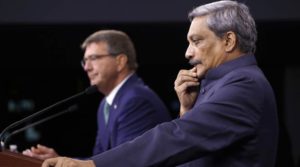
Nearly three months after the Logistics Exchange Memorandum of Agreement (LEMOA) between India and the US was signed in the presence of Defence Minister Manohar Parrikar and his American counterpart Ash Carter, the pathbreaking agreement is yet to be operationalised. The agreement allows the Indian and American militaries to access each other’s bases for supplies and repairs.
The delay is because the defence ministry has not shared its “points of contact” list with the Pentagon. Ministry sources said a routine bureaucratic process was involved, wherein an accounting standard for the three services is still being worked out. It forms part of the “points of contact” list to be submitted to the Pentagon.
The “points of contact” list is a list of designated officials, with their contact details, to whom the US military would have to send its request for logistics support under LEMOA. The Americans furnished their “points of contact” list at the time the agreement was signed. Senior US government officials told The Sunday Express they were confident of the LEMOA being operationalised, and were not looking at a specific deadline.
Although it has not been officially announced so far, Defence Secretary Carter will be making his farewell visit to India early next month. No progress is, however, expected on the other two pending foundational agreements, the Communications Compatibility and Security Agreement (COMCASA) — formerly known as the Communications and Information Security Memorandum of Agreement (CISMOA) — and Basic Exchange and Cooperation Agreement (BECA). These agreements allow for the secure exchange of communication between the militaries, and the sharing of geospatial data, respectively. The defence ministry has not shown any interest in the Pentagon’s attempts to resume negotiations on these two agreements.
The two sides have, however, been negotiating hard on defining the exact contours of the Major Defence Partner (MDP) status bestowed by the US on India. This is a unique nomenclature created solely for India, and was announced during Prime Minister Narendra Modi’s visit to the US in June. During Parrikar’s visit to the US in August, he had shared with Carter a non-paper on India’s expectations from the MDP status. The two sides have since exchanged multiple notes on the subject and a clear framework on the MDP status — which will allow India to get the latest defence technologies from the US — is expected to emerge during Carter’s visit. No official announcement is expected to be made, though.
During Carter’s visit, the two sides will discuss the impact of the political transition in Washington on the India-US defence relationship. American officials say that institutional mechanisms created during the Obama administration, such as the DTTI and MDP status, will ensure a healthy relationship between the two countries. They, however, concede that the next defence secretary may not necessarily share the personal chemistry that Carter shares with Parrikar. US officials gave the example of a meeting at the Pentagon, where, they said, Carter, a physics major, used the metaphor of the Zeeman’s Paradox to describe the bilateral relationship. While all the other officials were flabbergasted, Parrikar, an IIT graduate, went on to recite the full formula of perspective geometry.
The two sides are expected to announce the signing of the much-delayed M777 howitzer deal during Carter’s visit. The Rs 5,000 crore deal, which has been approved by the Cabinet Committee on Security, and for which funds were sanctioned by the finance ministry earlier this month, envisages the procurement of 145 heli-portable artillery guns, which will be assembled in India. This will be the first induction of artillery guns in the Army since the ill-fated 155 mm Bofors guns in the 1980s.
Source: http://indianexpress.com/


















